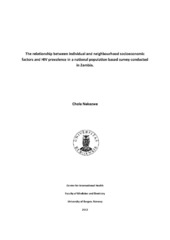| dc.description.abstract | Background: Emerging issues in HIV prevention include the importance of considering underlying social and economic factors at the community and individual level. We examined the associations between individual and neighbourhood socioeconomic position (SEP) on HIV prevalence in young people in a high HIV prevalence country. Methods: The study re-analysed data from the Zambia Demographic and Health Survey, a cross- sectional nationally representative survey conducted in 2007. A two stage cluster stratified systematic sampling procedure was used to select a sample of 14,554, of which 10,444 were successfully interviewed and tested for HIV. Young people (aged 15-24 years) accounted for 40.7% of the sample (n=4,253). Neighbourhood level variables were derived by aggregating the individual level SEP indicators wealth, educational attainment and employment. A composite SEP indicator was constructed by a linear combination of SEP indicators and a neighbourhood level SEP indicator was derived by aggregating the composite SEP indictor. Multi-level mixed effects logistic regression models were used to examine the association between HIV prevalence and different measures of SEP at individual and neighbourhood level. Results: HIV prevalence among young people was 6.5%. The prevalence was higher in urban than rural areas (8.5% compared to 4.7%). A higher proportion of young women (8.5%) were infected with HIV compared to young men (4.3%). In rural areas, young people from high employment neighbourhoods were less likely to be infected with HIV (Age adjusted odds ratio (AOR) 0.34, 95% CI 0.18 - 0.63). However, living in neighbourhoods with middle educational attainment and the wealthiest neighbourhoods increased the risk of HIV infection. Neighbourhoods that scored high on the aggregate composite SEP indicator were also associated with increased odds of infection. At individual level better education and high composite SEP reduced the odds of HIV infection in urban areas, whereas there was no significant association for these two individual variables in rural areas. Employment reduced the odds of being infected in both rural and urban areas ((AOR 0.53, 95% CI 0.34 - 0.81) and (AOR 0.65, 95% CI 0.46 - 0.91), respectively). Controlling for neighbourhood SEP indicators did not affect the significant association of individual SEP indicators in urban areas, while in rural areas the associations were affected. Conclusion: There were marked differentials by residence in the way underlying socioeconomic factors affects HIV transmission both at the individual and community level. Our results suggest that community level factors have a more important influence in rural than urban areas. Preventive strategies targeting community level factors are urgently needed | en_US |
